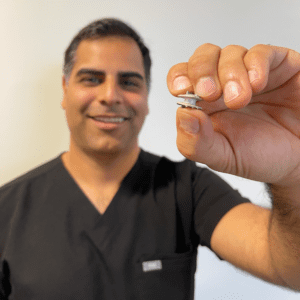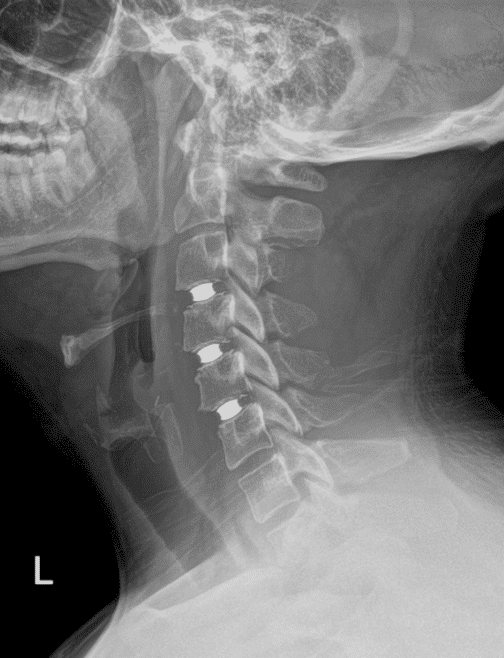Disc Replacement Surgery
Preserving & Restoring Motion
Welcome to The Disc Replacement Center at VSI.
Customizing Treatment to Keep You in Motion
At VSI, we offer a unique approach to customizing disc replacement surgery, creating tailored surgical solutions at each level of the spine that are proven to maintain the natural motion of the spine. This includes single-level, multi-level, and hybrid combinations with spinal fusion. The creativity in our approach provides patients with the most tailored solution for their specific condition and translates to longer-lasting results and a restored quality of life.
Preserving motion is the primary goal of disc replacement, ensuring patients remain active and live pain-free. Minimally invasive procedures like cervical disc replacement and lumbar disc replacement offer significant benefits by maintaining the spine’s natural movement while alleviating pain caused by damaged discs. With advanced artificial disc replacement technology, patients experience long-term relief from conditions affecting the cervical or lumbar spine.
What is Disc Replacement Surgery?
Disc replacement is a surgery to remove and replace a damaged disc to restore motion and reduce pain. The phrase “you need spine surgery” scares many people. Fortunately, with the development of modern techniques and technologies, VSI’s spine surgeons can vastly improve a patient’s quality of life with minimally invasive surgery. The artificial disc is one of the modern technologies benefiting patients suffering from debilitating neck or back conditions by allowing them to regain their full and active lives after surgery. Historically, if someone suffered from disabling neck or back pain the common treatment available was to remove the bad disc and fuse (spinal fusion) one bone (vertebra) to the next one. Over the past several decades we have developed improved fusion techniques, but the most progressive has been the development of the disc replacement (non-fusion) option. Today the use of artificial discs in the spine has vastly improved results for patients. Spine surgeons can remove a painful degenerative, and/or herniated disc and replace it with a new motion-preserving artificial device that keeps the patient functioning and in motion without debilitating pain.
How is Disc Replacement Surgery Performed?
- The spine is composed of a column of bones (vertebrae) connected via discs.
- The disc is a strong ligamentous structure allowing for distraction, compression, flexion, extension, side bending, and rotational movements. The discs can function properly when these motions are preserved.
- There are two small joints (facet joints) in the back of the spine at each disc level.
- Together the large disc in the front and facet joints in the back make up a 3-joint complex known as a motion segment.
When we surgically perform a disc replacement, we remove the damaged disc in the front and put a synthetic device in its place, which allows the motion of that 3-joint complex to be restored. This concept is very similar to total hip replacement surgery; however, in the spine, we must consider the health of the facet joints. Think of a spinal motion segment as a tricycle. We can replace the big wheel in the front (the disc) but rely on the two small wheels (facet joints) in the back to function. If the facet joints are reasonably healthy, then replacing the big disc in the front with an artificial disc allows us to preserve motion, restore function, and eliminate pain.
When we can preserve motion, we are doing that. When stabilization is required, then spinal fusion is optimal. Sometimes we combine these technologies, where we fuse (spinal fusion) the most unstable or degenerative level and then perform a disc replacement at the other levels, still producing excellent clinical results compared to a fusion-only procedure. Through modern technological evolution, enhanced surgical techniques, and elite physician knowledge, we can restore our patients to full and active lifestyles.
The Benefits of Artificial Disc Replacement Surgery
This modern, motion-preserving disc replacement technique, combined with advanced surgical technologies, offers a more effective treatment option than ever available in the past. The benefits of spine disc replacement surpass traditional spine surgeries.

Living Life in Motion
Many patients considering spine surgery worry about altering their biomechanics and maintaining their mobility post-procedure to stay active. Disc replacement surgery alleviates painful neck and back conditions, enabling patients to return to their active lifestyle, athletic competition, and favorite hobbies and activities. This modern surgical technique preserves and restores the spine’s natural motion, ensuring patients can move safely and experience long-term benefits.
Am I a Candidate for Disc Replacement Surgery?
At your surgical consultation, your spine surgeon will perform a thorough assessment to determine if disc replacement surgery is right for you. Our in-person consultations are reserved for approximately one hour to one hour and a half to provide the time necessary to cover all aspects of your diagnosis and to create a custom treatment plan for you. This time includes answering all your questions, addressing your concerns, performing a hands-on medical exam, taking a detailed medical history, and reviewing your current X-rays and MRI.
Disc replacement surgery is most commonly used to treat the following conditions:
- Degenerative Disc Disease
- Spinal Stenosis
- Disc Herniations
- Radiculopathy
- Failed Prior Surgery (Failed Fusion)
- Multi-Level Damages
- Prior Spinal Fusion on Adjacent Levels

Customized Disc Replacement Solutions
At VSI, we believe in an ultra-customized approach to disc replacement surgery, tailored specifically to each patient’s unique anatomy. Instead of using a one-size-fits-all solution, we carefully select the most suitable device for each individual, ensuring that the treatment aligns perfectly with the patient’s anatomy. This level of customization sets us apart from other centers, where standard procedures often overlook individual variations.
We also recognize that no two damaged cervical or lumbar discs are alike, especially when multiple levels of the spine are involved. Each level of disc damage deserves its personalized treatment plan. At VSI, we don’t fuse all damaged discs; instead, we customize the treatment for each level, restoring natural motion and reducing stress on adjacent discs – which reduces the risk of future treatment.
By replacing multiple damaged discs, we not only alleviate pain but also restore stability and promote healthier function across the spine. Our approach to multilevel disc replacement preserves mobility, minimizes the risks of traditional fusion surgeries, and offers our patients long-term benefits other centers simply don’t provide.
Frequently Asked Questions About Disc Replacement Surgery:
Check with an Expert if You’re a Candidate for Artificial Disc Replacement
Take the first step toward a pain-free, active lifestyle. Schedule a consultation with our VSI spine surgeons today for a personalized assessment and learn if disc replacement is the right solution for you.

